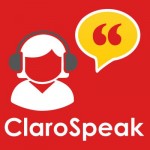There are a number of assistive-type softwares that may help students with access to learning in the classroom. The following focuses on writing, reading, and vision supports. Most are free and can be easily downloaded by the student.
- EASE of ACCESS: This group of tools offers simple word prediction through the on-screen keyboard, magnifier (for vision support)… Click here for instructions. Note the different ways to gain access whether you are a teacher or student.
- SpeakIt: Google Chrome extension that provides text-to-speech for most web content. Has a range of voices and languages to choose. Options are available to adjust the speaking rate and pitch of voice. This is a good one!
 ClaroSpeak: Google Chrome extension is a simple text-to-speech reader with word prediction, editing, proofing and speaking dictionary. There is also a more powerful paid app for ipads that includes access to pdf.
ClaroSpeak: Google Chrome extension is a simple text-to-speech reader with word prediction, editing, proofing and speaking dictionary. There is also a more powerful paid app for ipads that includes access to pdf.- Rewordify: This is a site that I’ve written about before and is well worth repeating. (Click here for previous post) Any text can be pasted into the box and it will return a simplified version – very quickly I might add. One of the options deserves highlighting. Retaining the original word within the text, while offering a simpler form provides two things: increase of comprehension and increase of vocabulary. Sitting side by side, relationships between the difficult term and easier one is visually connected. As well, the integrated dictionary allows access to almost all of the words in the selection. Finally, the content can be printed and stored.
- Word Talk on MSWord: Text-to-Speech toolbar is part of computer images (click on the tab, ADD-INS). This toolbar provides reading support as well as a simple word prediction dictionary.
- Kidspiration and Inspiration (graphic organizer to writing): While this is not technically assistive software, it does have a sound recorder that can support memory or as an audio file embedded within the graphic organizer. The recorder will also show up in Outline Writing view. This provides a seamless process from ideas generation to written output. All sd41 teachers can have a personal full copy of the software for home use. (See our FORMS page for information on TAKE-HOME software.)
- Kurzweil 3000: This software is the cadillac of assistive softwares. It will read almost any digital information (print, electronic, pdf or the Web) in clear, synthetic speech, while a dual highlighting feature adds visual reinforcement. This provides a digital means of engaging with text and supports those students who require alternative methods for accessing, writing and recording information. Click here for more information.
- iWordQ-CA ($29): This is an ipad app that mimics a simple version of what you would expect from the more robust Kurzweil 3000. In writing mode, text editor includes word prediction, spell checker, dictionary and speech recognition. In reading mode, text-to-speech offers proofing and reading options.
- Add language keyboards to Win7 devices – access other languages through added keyboards. Click here for instructions.
Do you have any favourites that integrate with reading or writing? Drop a comment in the box below. I’d love to add to the list.



